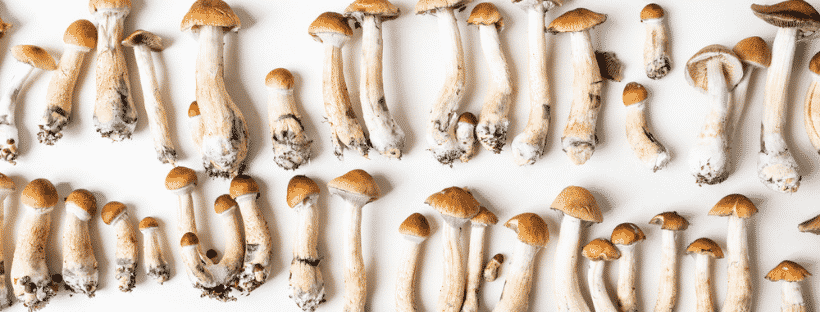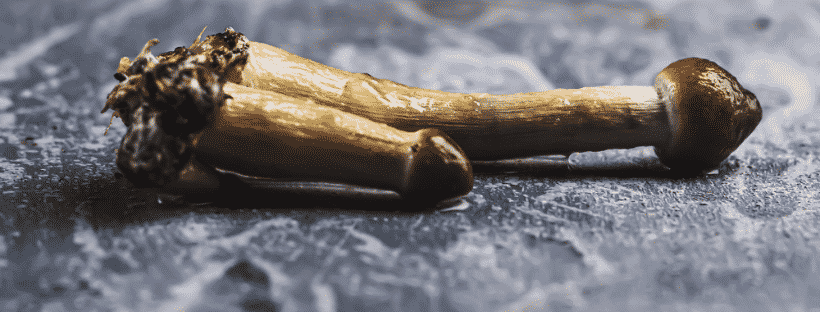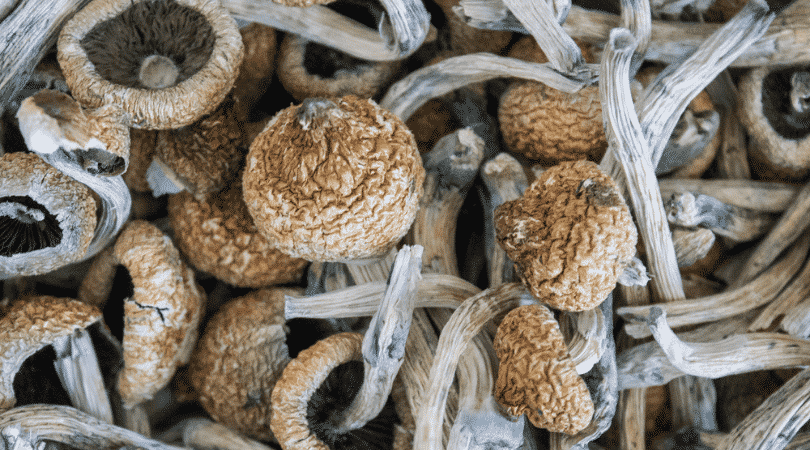In the wonderful world of magic mushrooms, there is quite a bit to learn still. That does not just apply to those who use magic mushrooms but also to those who study, cultivate, and research them every day.
There are more than 200 types of mushrooms that grow naturally in the world. More than 100 mushrooms contain three psychedelic compounds: psilocybin, psilocin, and biocytin. These compounds function in a similar way to human serotonin, a chemical in the human brain that helps send messages to our organs. Its primary responsibility is controlling our emotions and mood, so when magic mushroom compounds bond to your brain, serotonin receptors fire.
Psychedelic mushrooms are more formally known as Psilocybe mushrooms. Think of their strains as you would their cannabis counterparts. With cannabis, you have Indica and Sativa strains. With magic mushrooms, you have azurescens, cyanescens, semilanceata, and cubensis. The latter is the easiest to cultivate and is the most popular species used to make products found in dispensaries.
As we see with cannabis, magic mushrooms can be cultivated into different subspecies and strains, creating a wide array of results. Think of those subspecies as you would Black Diamond cannabis and Bubba Kush cannabis.
The Wonderful World of Magic Mushrooms
Magic mushrooms contain the psychoactive ingredient psilocybin, and they have been around for hundreds or possibly thousands of years. Some anthropologists claim to have seen hallucinogenic mushrooms in cave drawings that date back almost 9,000 years. For the past five decades, these little fungi have been illegal in Canada after being officially outlawed in Canada in 1974. In August 2019, that started to change when the law was adjusted and allowed the Health Minister to issue exemptions so that people could use them for potential medical purposes.
Many people thought magic mushrooms were a hard drug that offered no potential benefit to humans until recently. The United Nations Convention on Psychotropic Substances Committee decided that psilocybin, the psychedelic compound in magic mushrooms, should be a Schedule-I substance, but not the mushroom itself. That decision, eventually, became part of the Vienna Agreement and stated the committee does not believe there are any therapeutic benefits that mushrooms provide humans. The real focus of that decision was LSD since this happened in 1971, but mushrooms ended up in the mix.
People are starting to change how they look at these fungi, and researchers are spending more time looking into what secrets they may hold.
In some cultures and countries, magic mushrooms are considered part of their history and traditions. The ancient Mayan and Aztec tribes used psychedelic mushrooms as part of their ceremonies for centuries. Some groups still apply this same reasoning to why they use magic mushrooms in modern-day ceremonial events.
There are more ways than ever to consume magic mushrooms, and they are now often found in edibles, capsules, and microdoses. With so many species of psychedelic mushrooms available today, it is easy to be lost in the woods, but we are here to help you navigate this world.
Magic mushrooms contain a psychedelic compound called psilocybin. When this compound enters your brain, it is converted to psilocin and is believed to influence serotonin levels in the brain. When those levels are elevated, your brain can start to experience altered perceptions of sights, sounds, and experiences.

1. Azurescens
Azurescens grow in the Western United States up to Canada and in large groups in Oregon around the Columbia River delta. This species needs sandy soil, which is why it grows near decaying wood and seagrass near water. Although it mainly grows up and down the west coast of the United States and into western Canada, this strain can now be found in places across Europe as well.
This species starts producing fruits in late September. Usually, it continues fruiting after the first frost appears, until the end of December or early January. Perhaps one of the best upsides to this species is that it grows well in cold climates, unlike other magic mushrooms. It can typically tolerate temperatures between 15 and 25 degrees Celsius. One downside to this species is the bitter taste that users say it has, so keep that in mind if you plan to use this one.
It has one of the highest psilocybin concentrations, reaching upward of nearly two percent, at least three times higher than cubensis or semilanceata. That means it’s potent, and if you plan to try this species, take it easy. On average, the azurescens species of magic mushrooms have a 1.7 percent psilocybin concentration, meaning they can be pretty powerful, especially for first-time users.
Some users report using a little too much of this product and dealing with temporary paralysis’s potential side effects. That’s not necessarily a good thing, and it can lead to anxiety attacks if you are not expecting it to happen. On the other hand, many users have enjoyable experiences, reporting seeing intense visuals and taking insightful inner journeys.
2. Semilanceata
This magic mushroom species is also known as liberty caps or witch’s hats, and it is believed to be the most abundant fungi to grow in the world. It is also considered among the more potent species of psychedelic mushrooms.
This species does grow in feces and moist plots of land, such as a meadow or a pasture. It’s been found throughout the United States, Mexico, and Europe, and it typically grows in the late spring, summer, and early autumn. It is most often found in the Western United States and Canada and not as abundant up and down the continent’s Eastern half.
On Nov. 16, 1799, a man wrote a letter to the editor of The Medical and Physical Journal saying he and his family picked mushrooms from a park and experienced various effects. According to the letter, the father was overly concerned about vertigo they all suffered, but he ate quite a few of those mushrooms that day. These would later be identified as the semilanceata species of magic mushrooms.
Fast forward to today, and many users say these give you a similar experience to that of using a mild dose of LSD. This species should be handled with care because psilocybin levels can be excessively high. Semilanceata can have a concentration range between 0.2-2.4 percent, which is exceptionally high compared to the other magic mushrooms.
You may find that your trip from this species is more joyful and fun. Many people have described becoming more talkative than usual; they burst into laughter and become more empathetic toward others.

3. Cyanescens
The cyanescens species of mushroom live in many places worldwide and is one of the more potent magic mushrooms to grow indoors. It is also unique in appearance to the other species, although it looks similar to the cubensis type of magic mushroom aside from the fact that it has wavy caps.
An interesting thing about this magic mushroom species is that it can grow in small gardens or huge patches. It often grows in wood debris and mulch used in gardening, which may spread around the world. It thrives in humid climates and grows well in Mexico and Central and South America, although Hawaii is where it is most often found.
One thing that sets these two apart from each other is their concentration level. Cyanescens are a rather potent species of magic mushroom and can often average around 0.39-0.75 percent psilocybin. When compared to the cubensis species of magic mushrooms, this strain is much more powerful.
Users suggest ingesting this magic mushroom species when it’s fresh instead of dry, although it does produce strong effects even if it’s dried. This species tends to give users a hangover-like feeling before the full effects of the psilocybin kicks in. Many users describe their trip with cyanescens as very visual and colourful and deep creative and visionary thoughts.
4. Cubensis
This species dates back to the early 1900s, and it’s most commonly used in magic mushroom products you find today. Although it is the most popular species we use, it is not the strongest by a long shot. This species typically has a 0.14-0.42 percent psilocybin concentration, but that is still enough to experience an intense trip.
Cubensis reaches full bloom in September, but its season typically wraps up by November. It takes about two months to grow to its full size during late summer when it’s hot often. This species naturally grows in hot, humid climates such as Florida, Cuba, and even the Amazon rainforest.
Because this species is used in so many different types of products, it can be hard to predict what kind of experience you may have. The result will depend on several factors, just like any other psychedelic, mainly your current state of mind.
A cubensis trip is often described as light, simple, and easy to navigate, especially compared to some other species. Many people report visual and audible distortions with this magic mushroom species, but it is recommended for first-time users.

A Good Trip
There are four phases you will likely experience during your trip for those who have never tripped before. It starts with ingestion, then onset, peak trip, and come down, and each phase will be very different from the others.
Many people compare a magic mushroom trip to an LSD trip, but there are some significant differences. The main difference between mushrooms and LSD is the length at which you will experience the trip. LSD side effects can linger for up to three times as long as those of magic mushrooms.
With most magic mushrooms, the overall trip experience will be similar at each level of consumption. With microdosing, you shouldn’t feel any tripping sensations or severe side effects. With low doses, you’ll experience dilated pupils, physical and mental relaxation, and possibly a sense of calm. These effects typically begin about 20 minutes after use, and they last four to six hours. With slightly higher doses of magic mushrooms, you will start to experience more potent side effects, including visual and mental hallucinations, feelings of space and time being distorted or altered, and increased creativity.
If you overdo it, you can experience what’s known as a bad trip.
A Bad Trip
You have likely heard of someone experiencing a bad trip after ingesting magic mushrooms. No matter which species you use, you run the risk of suffering a bad trip if you are not in a safe, comfortable setting and take too much at first.
Several side effects can accompany a bad trip, including paranoia, anxiety, and paralysis in serious situations. If you find yourself in this type of situation, remain calm and remember it will pass. The risk of a bad trip is the main reason you want to be in a safe, comfortable place before consuming magic mushrooms. If you’re in a bad mood for any reason, maybe avoid consuming mushrooms on that particular day, and try again when you’re feeling a little more jolly.

Closing Thoughts
With any magic mushrooms exists the possibility of dealing with a bad trip. As long as you know that going in, you are ready for what may come.
Remember, your dosage has quite a bit to do with what happens in the end. If you are new to magic mushrooms, take it slowly, and even if you’re more experienced with them, it’s not a bad idea to start with a small amount and work your way up. Just like with cannabis, every strain and species can function a little differently from another, so you may never know what you’ll genuinely get until it happens.
Above all else, make sure you are in the right headspace and with people you know, enjoy, and are comfortable with or otherwise, you run a high risk of going down the wrong path and getting stuck there for hours.



Comments are closed.